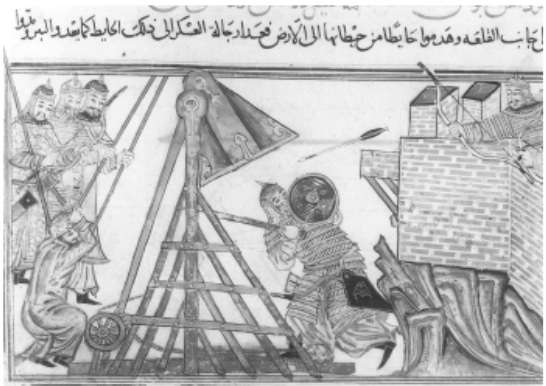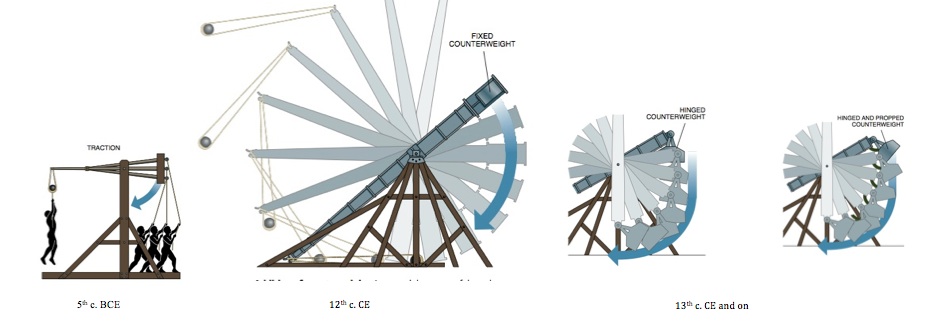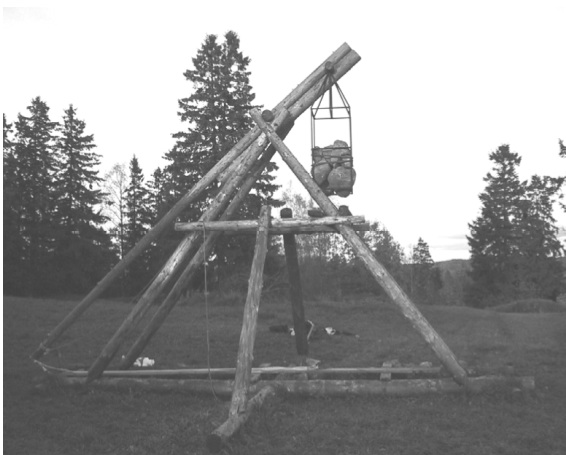-King Richard’s trebuchets hurled constantly by day and night. It can be firmly stated that one of them killed twelve men with a single stone. That stone was sent for Saladin to see, with messengers who said that the diabolical king of England had brought from Messina, a city he had captured, sea flint and the smoothest stones to punish the Saracens. Nothing could withstand their blows; everything was crushed or reduced to dust.

-At last the larger machine was put up and great rocks were cast at the fort. The men in the fort, seeing the size of the rocks, conceived a great terror. The duke took charge of the machine, shot the first stone, and crushed the enemy’s balcony and the men in it. He shot a second one and dislodged the planks and the logs of the rampart. He discharged a third one and pierced and shattered three large logs in the rampart and struck some men. After seeing this, the people in the fort fled from the ramparts and sought safer places. But since they had no refuge, they asked for quarter so that they could come down and make their plea to the bishop.
-Henry of Livonia in his Chronicle of Livonia describing the siege of Mesoten by the Teutonic crusaders in December 1219
-John I, archbishop of Thessalonike, 597 on Avaro-Slavs battery of 50 traction trebuchets: “they hurled mountains and hills against us”
The destructive power of the trebuchet was effective centuries before gunpowder and well after the introduction of guns. Developed in China between 5 and 3 BC, the trebuchet reached the Mediterranean by 6 AD, succeeding the Roman derived onager or the similar magonel. The trebuchet’s use of gravity, rather than torsion to hurl its projectile made it vastly more effective than previous siege engines. While the average magonel launched projectiles of approximately 20 kilograms, a trebuchet could launch projectiles weighing one metric ton, with a greater range and a faster rate of fire.
The trebuchet drew its great power from physical principles, using long and short arms to generate leverage: on the end of the long arm was the projectile, and on the short arm was the source of power. The earliest trebuchets had ropes attached to the short arm, which would be pulled by a crew of operators. As technology advanced, counterweights were eventually implemented after a hybrid period, and later on hinged and propped counterweights came into use.

The earliest accounts of counterweight-operated trebuchets are from the middle of the 12th century Islamic countries, Byzantium and Mediterranean area of Europe. With this new advancement the trebuchet reached the peak of its destructive potential, described in many texts only as “big,” “great,” “huge” or “frightful” machines. Counterweights could be the size of a peasant’s hut, weighing tens of thousands of kilos and the projectiles of heavy trebuchets weighted 200 to 300 kilos, and in extreme cases more than 1000 kilos.
While the trebuchet was in principle a simple machine, in reality it required knowledgeable engineers to achieve such devastating results. The counterweight trebuchet functions by converting the potential energy of the counterweight into the kinetic energy of the projectile, however, realistically trebuchets only achieve 10%-70% of their theoretical maximum potential energies. Why is this? Experimental Archaeologist Tanel Saimre declares that “the trebuchet is a complicated machine and thus can only be fully understood through practical experience.” This statement was proved by Conquistador Hernan Cortes in his 1521 siege of Tenochtitlan; with ammunition running low, he and his crew decided to construct a trebuchet with which to continue the siege, however, its first and only shot went straight up and crashed down, destroying the machine. After constructing a trebuchet of his own, Samire details his findings on the optimal working conditions of the trebuchet:
Workings of the Trebuchet:
-The Sling: At precisely the right moment the loop slides off the hook and the sling opens, releasing the missile. The length and curvature of the hook must be exactly correct for the sling to open at the right moment – when the counterweight has reached the bottom of its trajectory and the tangent of the missile’s trajectory is at the desired angle. In addition, a longer sling increased the effective length of the throwing arm, improving release angle and the distance of the projectile.
-The Counterweight: The first concern was the mass, with larger counterweights providing more power and distance, but requiring a longer amount of time between shots. A hinged counterweight eases strain on machine, braking it as it releases the projectile. This lack of straining led to greater accuracy, as the trebuchet would move less in firing. A propped counterweight slightly increased the potential energy of the machine by elevating the weight.
-Long to Short Arm Ratio: This ratio, along with the axle height was crucial in constructing an effective trebuchet. The ideal ratio was much debated, but is supposedly somewhere around 5:1.4
Looking at the siege engine itself, we find that the raw power and destructive capability of the trebuchet have played a part in its cultural impact. Just as enthusiasts today display an outlandish affection for their trebuchets, so did the operators of the past: given names like “The Great Trebuchet,” “The Daughter of the Earthquake” “The Mother,” “Bad Neighbor” and “The Old Woman,” it is easy to see that high regard was given to these siege engines. One trebuchet, called “God’s Stone-Thrower” was constantly accompanied by a priest, preaching, collecting money for its repair, and hiring men to gather ammunition. The trebuchet was clearly a powerful and awe-inspiring machine, but this alone could not have resulted in its salience.
 Samire's reconstruction
Samire's reconstruction
Back to The Catapult
Posted at Dec 22/2008 10:21AM:
chris witmore: Hi Willie. The image of the various trebuchets in different eras should be referenced.
